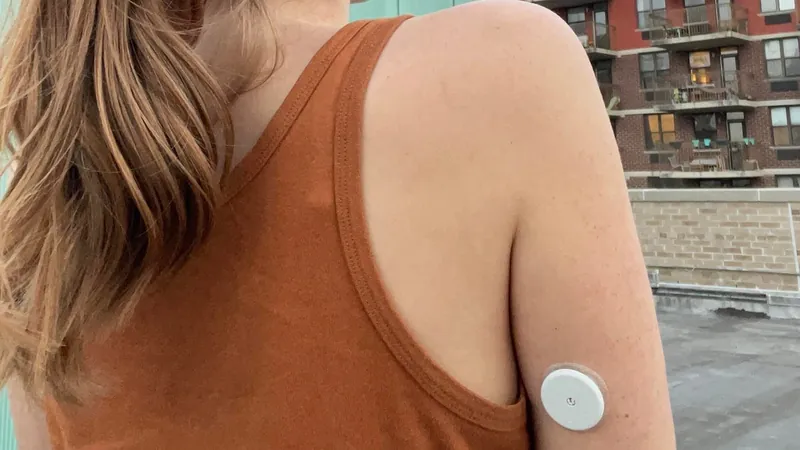
Why Tracking Your Blood Sugar Could Be a Game Changer for Your Health: My Lingo CGM Experience
2024-11-18
Author: Jessica Wong
For anyone looking to take charge of their health, continuous glucose monitoring offers a fascinating insight — and I recently embarked on an eye-opening journey with the Lingo continuous glucose monitor (CGM), developed by Abbott. My first experience with blood sugar tracking humbled me and brought to light its surprising connection to overall wellness.
Having previously tested the Stelo CGM by Dexcom, I was eager to compare it with Lingo. Abbott has successfully transitioned from a medical necessity to consumer technology approved by the FDA for adults seeking deeper insights into how diet and lifestyle impact blood sugar levels. With glucose being a critical marker of metabolic health — influencing our energy, mood, and risk for diseases like diabetes — understanding these levels can empower us to make healthier choices.
Lingo: A Closer Look
The Lingo CGM is a small, discreet device that adheres to the back of your arm, measuring glucose levels in real-time through a tiny sensor. This innovative technology offers a level of insight that typical health wearables still cannot match, as glucose tracking remains a challenge for companies like Apple, which is reportedly working towards integrating similar features into its smartwatches.
Why You Should Monitor Your Blood Sugar
Our bodies convert the food we eat, mainly carbohydrates, into glucose for energy. This process triggers an insulin response to regulate blood sugar levels. However, even those without diabetes may face risks when blood sugar stays elevated for extended periods, potentially indicating underlying health issues like insulin resistance, stress, or chronic sleep disturbances.
High blood sugar can lead to serious complications, including nerve damage and kidney problems. Fortunately, with the rise of CGMs, we are now better equipped to prevent and manage such conditions.
My Experience with Lingo
Setting up the Lingo was straightforward. I downloaded the app, sterilized my skin, and followed simple instructions to apply the sensor. The cost of a single biosensor is $49, providing two weeks of data. For a more extended commitment, there is a monthly option for $89 or a three-month subscription for $249. However, it's worth noting that Lingo currently only supports iPhone users, leaving Android users to seek alternatives like Stelo.
The app is intuitive and provides valuable insights, including a clear display of healthy glucose ranges (70-140 mg/dL), along with educational resources on the implications of glucose spikes. While I appreciated much of the motivational language, some messages felt overly prescriptive, prompting me to log every meal or undertake exercise after perceived spikes, which may lead to unhealthy habits.
Beneath the Surface: My Blood Sugar Observations
Having utilized Lingo for several weeks, I've noticed my glucose levels trending lower compared to when I used Stelo. These insights encourage me to adjust lifestyle factors — I found that taking a walk after meals mitigated my glucose spikes, a simple yet effective strategy for maintaining balanced levels.
Interestingly, I also observed the phenomenon of blood sugar crashes, particularly during afternoon slumps. On one occasion, fatigue hit me hard post-lunch, and my glucose dipped below 70 mg/dL. These drops can result from various factors, including meal composition and sleep quality.
Who Should Consider a CGM?
I believe everyone should consider a periodic check of their glucose levels, especially as a preventive health measure. While those diagnosed as prediabetic or with Type 2 diabetes might require regular monitoring, others can benefit from occasional self-assessments. Understanding how our bodies respond to foods can empower us to make healthier dietary decisions without obsessing over calorie counting.
With health trends all over the place, the utility of a CGM may offer clarity amidst the noise. My journey with Lingo confirmed that monitoring glucose isn't just for those diagnosed with diabetes — it’s a tool that can enlighten anyone curious about optimizing their health.
Ultimately, as I strive to improve my lifestyle — focusing on sleep and stress management — I plan to recheck my glucose levels about annually. The affordability of the Lingo sensor makes this approach feasible, and I look forward to seeing how my glucose trends develop over time.
In conclusion, whether you're managing a health condition or simply pursuing better health, a CGM like Lingo is an empowering option worth exploring!




 Brasil (PT)
Brasil (PT)
 Canada (EN)
Canada (EN)
 Chile (ES)
Chile (ES)
 España (ES)
España (ES)
 France (FR)
France (FR)
 Hong Kong (EN)
Hong Kong (EN)
 Italia (IT)
Italia (IT)
 日本 (JA)
日本 (JA)
 Magyarország (HU)
Magyarország (HU)
 Norge (NO)
Norge (NO)
 Polska (PL)
Polska (PL)
 Schweiz (DE)
Schweiz (DE)
 Singapore (EN)
Singapore (EN)
 Sverige (SV)
Sverige (SV)
 Suomi (FI)
Suomi (FI)
 Türkiye (TR)
Türkiye (TR)